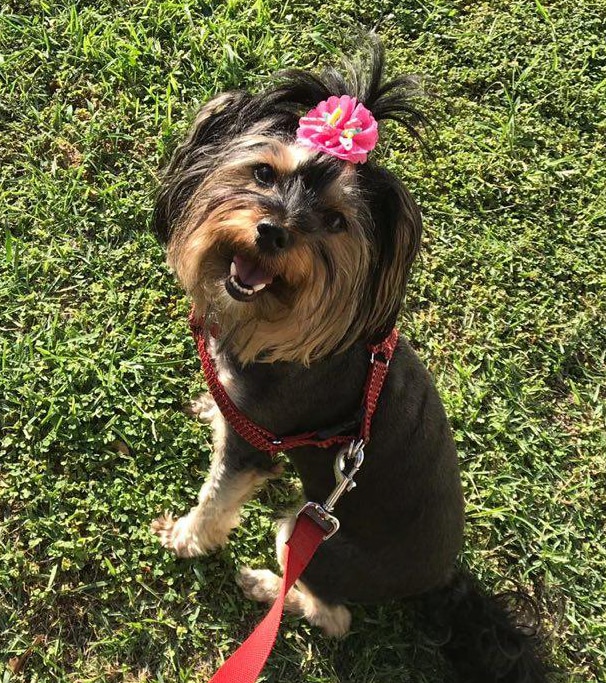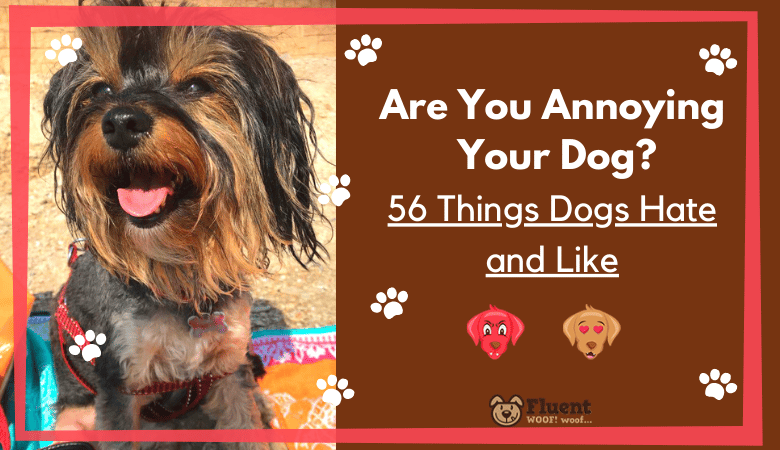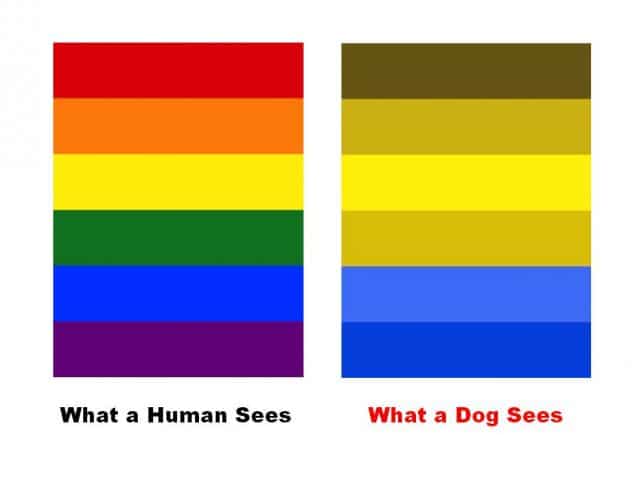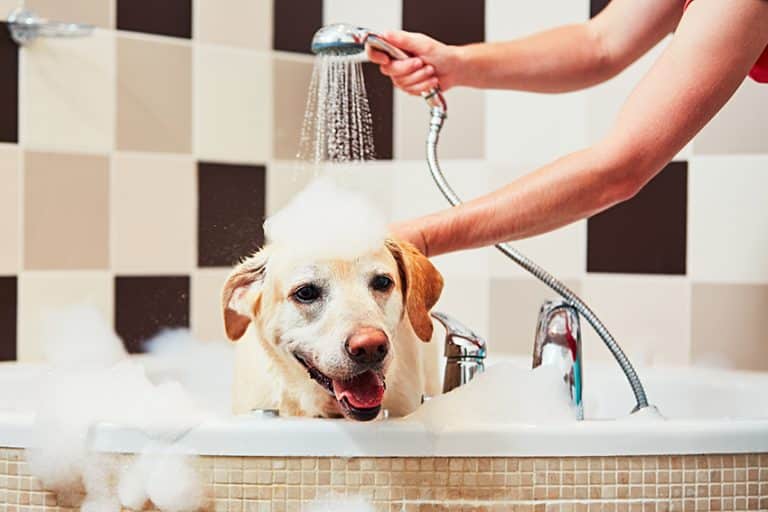Do you ever wonder what your furbaby likes and hates? According to Orhan Pamuk:
Dogs do speak, but only to those who know how to listen.
Orhan Pamuk
We’ve researched 56 things that dogs like or hate to help you hear what your pooch is telling you. Hopefully, this information can help you modify any unwanted behaviors and build a stronger bond with him.
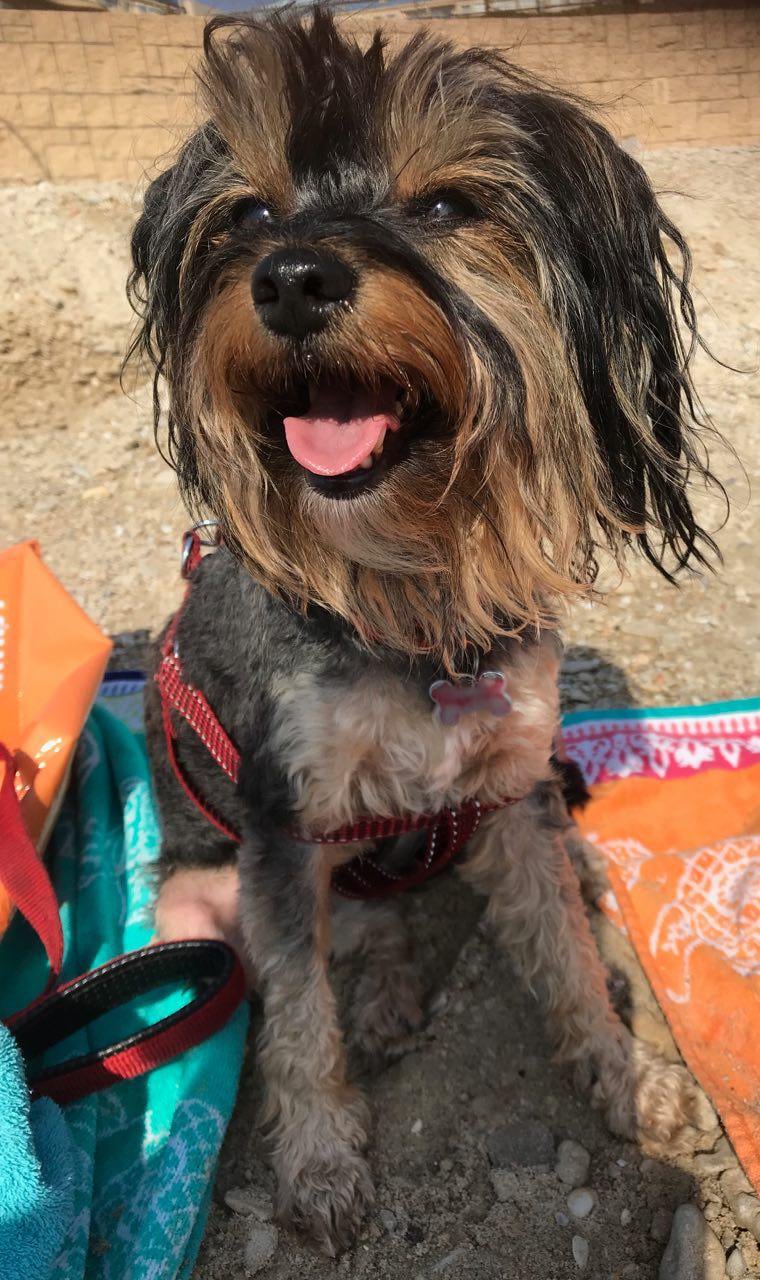
Sleeping with Owners

Our four-footed friends are pack animals. They’re usually born in a litter with other puppies. Sleeping with the family provides a range of benefits including:
- Warmth
- Mutual protection – there’s safety in numbers
- Companionship
When your pal climbs in bed with you, he’s also demonstrating affection. He wants to be around you and accepts you as part of his pack. But if your pooch doesn’t join you at night, no worries. Some dogs get too warm in a sleep huddle. Lying alone isn’t a sign that your dog doesn’t love you. He’s probably trying to stay cool.
Bottom line: Don’t force Fido to sleep with you, but welcome him if he comes up to cuddle. The good news for you is that cosleeping with a canine companion can help people cope with a variety of sleep disorders like nightmares, narcolepsy, and sleep apnea.
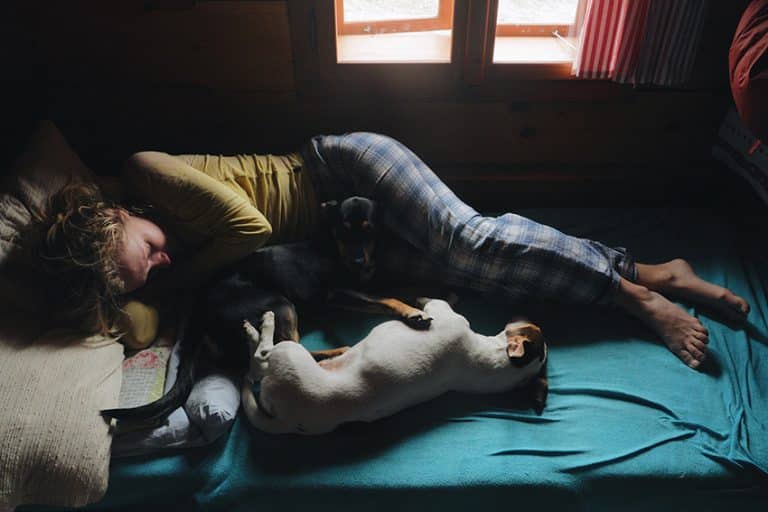
Listening to Bob Marley

We’ve heard that music soothes the savage beast, but what genre works best? A study published in the Journal of Physiology and Behavior researched this question. Based on the measurement of heart rate variability and urine cortisol levels to measure stress, the scientists concluded that soft rock and reggae were the most relaxing for pups. It turns out canines enjoy chilling out to Bob Marley.
Neal Evans, a co-author of the study, recommends playing soft rock or reggae for canines when they’re in stressful situations. So, putting on some tunes during the next thunderstorm could help your pal’s anxiety level.
Playing With Toys

Have you ever wondered why your pooch likes to play with toys? For some pups, it goes back to their wolf ancestors. Playing with fetch toys, chewing on a squeaky ball, or tearing up a plushie satisfies their hunting instincts. For others, a special object provides comfort and security.
If your furbaby has a favorite plaything, it probably associates the object with a special moment or activity they shared with you. Pups with a toy obsession may get excited every time you take time to play with them. The ball or other trinket reminds them of having fun with you.
You can encourage your pal and help them to avoid boredom by getting some playthings. Try activity toys or chew toys depending on your pooch to keep him occupied when you’re not home.
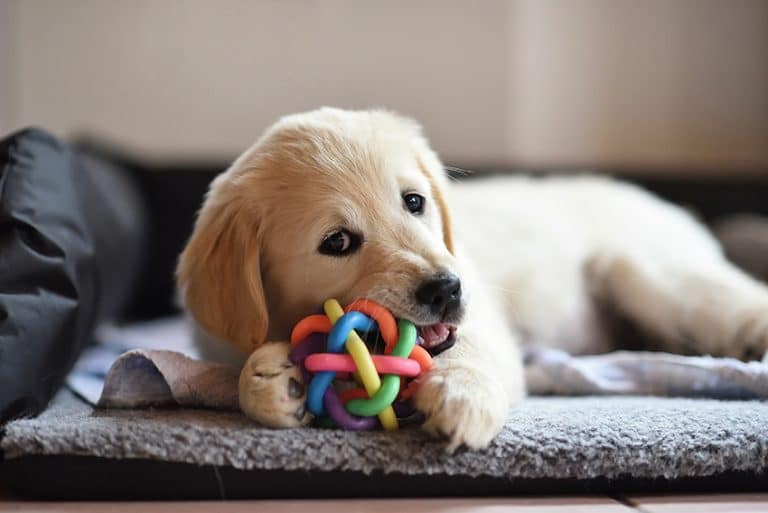
Watching TV

If you think your canine pal likes to watch TV, you’re probably right. In 2013, scientists in France reported that dogs can recognize and differentiate images on TV. What’s more, our pups can understand the barks and other dog sounds coming through the TV. They’re able to pick out dogs among people and other animals. Depending on your furbaby’s personality, he may sit and watch the screen, bark excitedly, run around, or ignore it.
What your dog sees is a little different from your perceptions. Dogs are only able to see a range of blue and yellow colors because their vision is dichromatic. Humans have a trichromatic vision and are able to pick out colors across the spectrum. In addition, a pooch can interpret images faster than ours can. The video feed on older sets isn’t in HD, so it appears like a flickering movie from the 1920s.
If your special pal likes to relax by watching the tube, tune into DogTV. This HD channel is specially designed for canines and provides images that capitalize on their dichromatic vision.
You could also leave the TV tuned to this station during the day to comfort your four-footed friend with background sound.
Spending Time in Crates

You may have heard that putting a dog in a crate is cruel, but that’s not true at all. By nature, pups are den animals. They like having a small, enclosed place that makes them feel safe and secure. If Fido doesn’t have an accessible crate, he’ll probably try to create his own space by hanging out under a desk or table.
The key to making your furbaby’s kennel a welcoming environment is using it appropriately. As long as you don’t use the kennel as punishment, your furbaby will learn to view it as a safe place or a bedroom.
If you haven’t crate trained your pooch yet, it’s not too late. Consult your veterinarian or a dog trainer about training techniques and picking the right kennel for your pal.
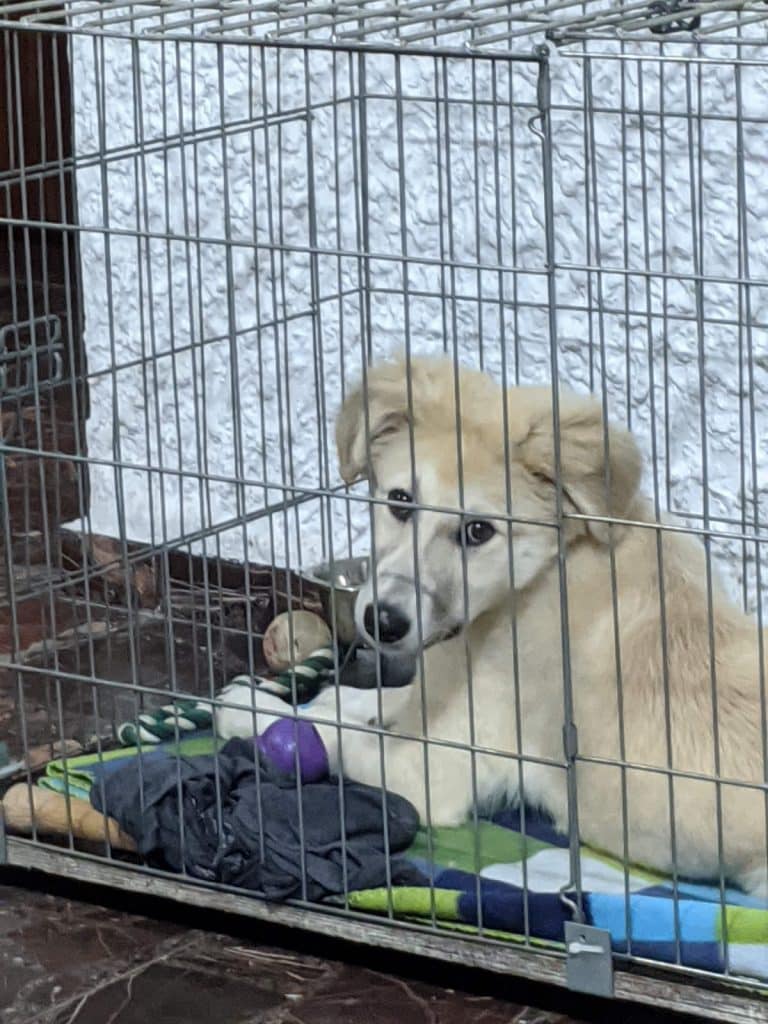
Hearing You Talk to Them Like a Baby

Researchers at the University of York found that dogs prefer it when their owners talk to them like they speak to babies. Known as Infant directed speech (IDS), humans often use a higher-pitched voice and different intonations to communicate with young children. We tend to mimic these patterns when we speak with our pups. Evidence suggests this kind of discourse combined with dog-relevant words strengthens the bond that we share with our furbaby.
The take-home message for you is to go ahead and baby-talk with Fido. Hearing “Who’s a good boy,” makes him feel loved and special.
Going Swimming

Most dogs love to swim, and here are a few reasons why:
Their bodies are made for water. Some breeds, like Labradors, have webbed feet and long legs for paddling. With an even weight distribution, they float well. Their tails can also make a good rudder for steering.
Others, were introduced to water when they were young. When training a dog to swim it’s important to let him adjust to the water at his own pace. Don’t force the learning process. Bringing along an older dog that wants to swim can help them overcome any fears.
If your pooch enjoys a dip in the water, plan a special outing. Spend some time bonding with your furbaby at the beach or lake, and remember to pack Fido’s life-vest.
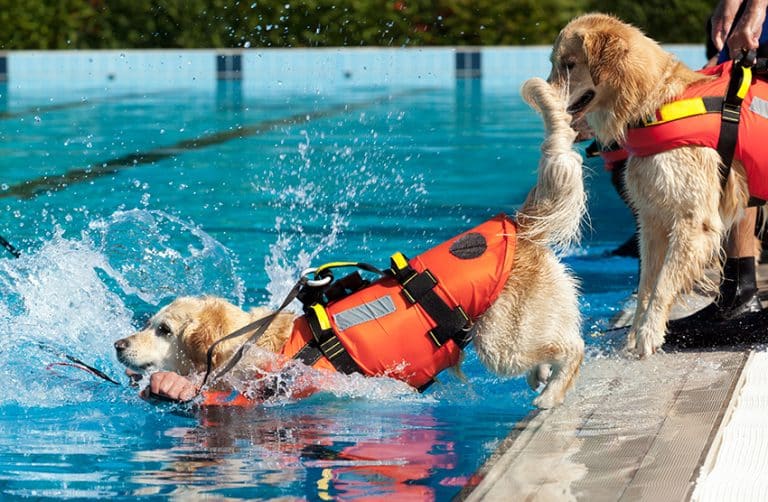
Sticking Their Head Out of the Car Window

Did you know dogs have about 45 times the number of scent receptors as compared to humans? Because of this, many scientists believe dogs poke their heads out the window of a moving car to capture the smells around them. Their highly-developed processing system lets them pick out different people, animals, food aromas, and more as you cruise down the street. When they combine that with what their eyes see, it heightens their senses for maximum enjoyment.
So, when you take your furry friend on a car ride, feel free to crack the window for him. He’ll enjoy the extra sensory stimulation. Give him enough room to poke his nose out, but make sure he can’t jump out of the car.

Some Breeds Love Comfy Sweaters

Some dogs, like my Springer Spaniel, come equipped with a heavy or double coat for cold temperatures. But other pups, particularly small and mini breeds, don’t have the built-in protection. Pooches that can benefit from added layers include:
- Pups that on the wee side
- Dogs with a thin hair coat or a short hair cut
- Senior canines
- Pooches with some metabolic diseases like Cushing’s or hypothyroidism
The key when you have dogs that are susceptible to cold temperatures is to help keep them warm. So don’t hesitate to buy something snuggly or get an ugly Christmas sweater for your furbaby.
Playing

Not only do dogs enjoy playing with their canine pals, they also enjoy interacting with humans. Our furbabies love to play with us because:
- They’re social animals
- Play in young pups helps teach social skills including bite inhibition
- Playing with humans offers the reward of social contact
- Interaction strengthens the human-animal bond
So, if your furbaby brings you a tug toy or his favorite ball, take some time to play. It benefits both of you.
Like It When You Kiss Them

The sad truth is that dogs don’t get it when we kiss them. However, recent research suggests that our furry friends can learn to enjoy the affectionate gesture. One study in 2012 evaluated interactions between 10 female owners as they interacted with their male Labrador Retrievers. Scientists measured the levels of oxytocin (the feel-good hormone) and cortisol (stress hormone) during a 60 minute period. They found that when owners showered their pups with kisses, the level of oxytocin increased suggesting that the pooches liked the contact.
These results suggest that we can teach our pups to enjoy our affectionate gestures. As long as your furry friend likes touchy-feely interactions, cuddle away. However, if Fido acts nervous or shows aggression, he may be one of those dogs that prefers his personal space.
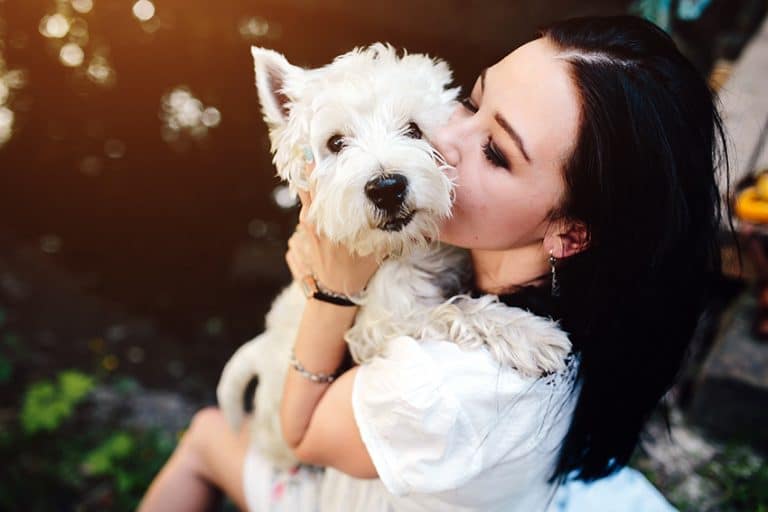
To Be Picked Up Or Held

If your pooch enjoys close contact, he’ll let you know by getting close. Your furbaby may paw at you, jump up, or lean into you. On the other hand, a dog that moves away, stiffens up, or snaps out is saying, “hands off!”
With patience and time, you may be able to teach your four-footed friend to enjoy being picked up and held. Here’s how:
- Learn the proper way to pick up and hold a dog
- Start small by holding your pal for a very short time period
- Reward your pooch every time to make it a positive experience
- Repeat several times before lengthening the holding time
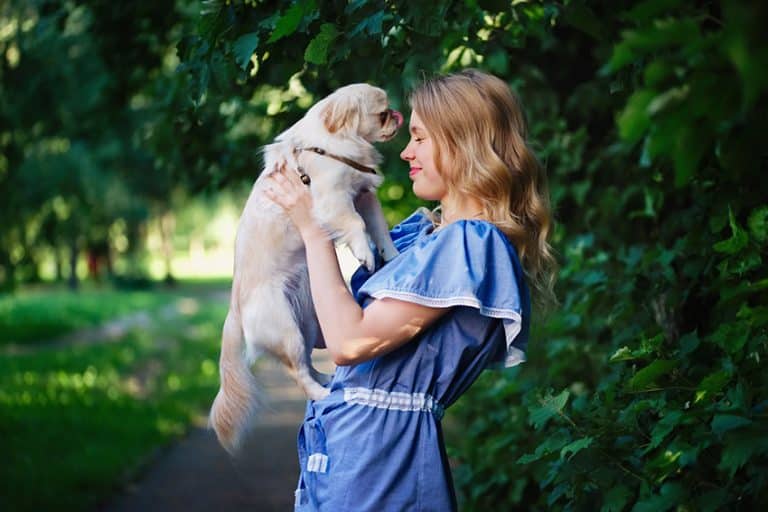
Chewing

For our canine pals, the behavior comes naturally. “Chewing, for a dog, is like a human opening a door and looking into a room,” said Colin Tennant, the chairman of the U.K. Canine and Feline Behaviour Association. “People are nosy, and so are the dogs. But they investigate with their mouths because they don’t have hands.” Pups may turn to gnaw on or tear things up because:
- They get nervous when you leave them alone
- They like the taste, texture or smell of something
- They don’t know the difference between a chew toy and other objects in the house
The key to stopping your pal from destroying your furniture and other household objects is immediate discipline. According to Tennant, “Dogs live in the moment.” If you wait too long to scold them, they won’t associate your rant with their chewing behavior, and nothing will change.
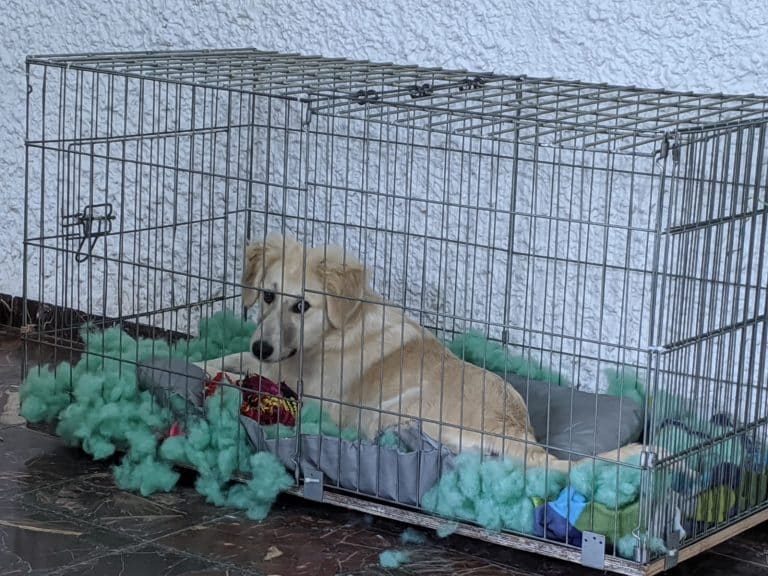
Chewing Toys

Dogs learn to explore their world early in life by chewing on things. They use their mouth to investigate their environment. That’s one reason that our furry friends like chewing on toys. Dr. Lori Teller, a professor at Texas A&M College of Veterinary Medicine & Biomedical Sciences, shares other reasons our canine companions like to gnaw. “Chewing can help relieve stress and anxiety, keep their teeth clean, and keep their minds stimulated,” she said. “Puppies also chew to relieve the pain and irritation of teething.”
There are many benefits to chew toys, but they’re not without risk. Dr. Teller listed potential hazards for popular items:
- Rawhides can cause digestive upsets, be a choking hazard, or lead to intestinal blockage.
- Antlers, bones, or hooves can splinter and cause cuts in the mouth, puncture wounds, or intestinal blockage. In addition, these items are hard and can chip or fracture teeth.
- Pig ears may be contaminated with Salmonella, which can infect both dogs and their owners.
- Nylon and rubber toys can become dangerous if your furbaby chews off and swallows large pieces.
- Rope toys can fray, and loose string can get stuck in the intestines.
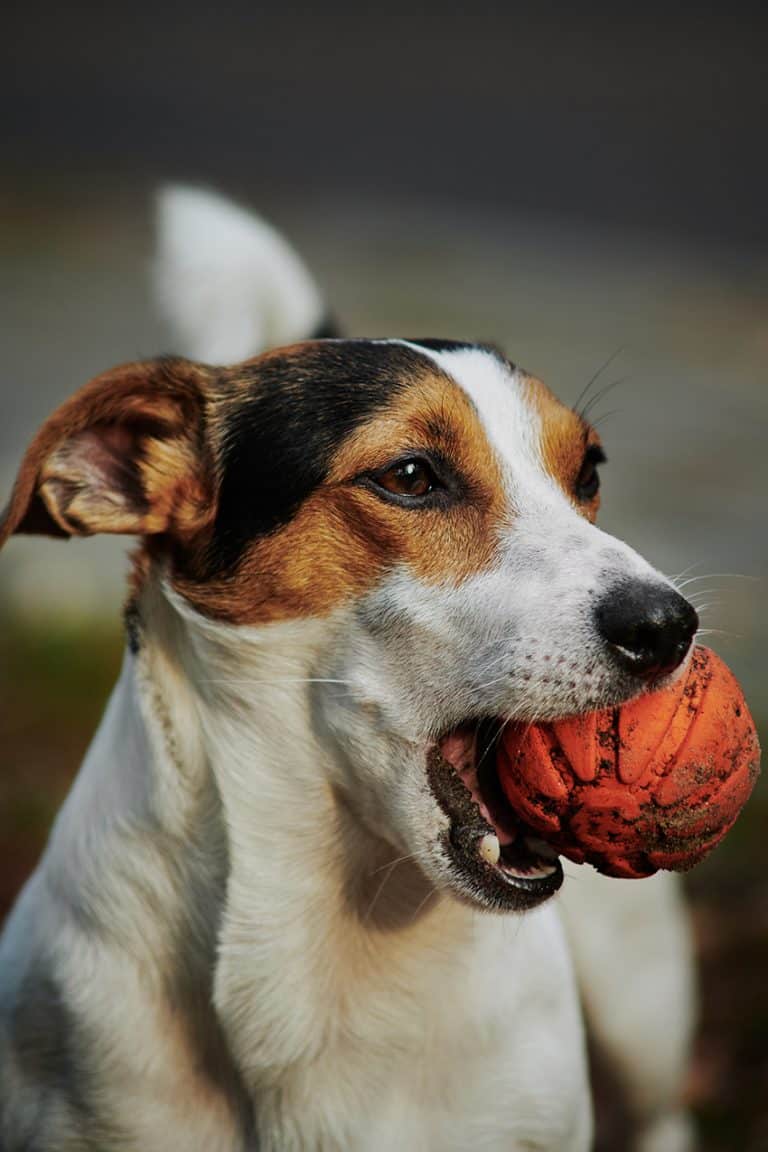
Dogs See Colors! Blue and Yellow

To find out how much our furbabies use their color vision, researchers studied whether test animals could discriminate between two visual cues based on color and brightness. For nine days, each dog was trained that a card of a particular color (yellow or blue) and brightness (dark or bright) was the correct cue to get a piece of meat. After training, the pooches underwent testing for 10 days. The results strongly demonstrated that the test animals picked the card based on its color regardless of its brightness. So, dogs will preferentially choose items based on color.
Love Car Rides

- Dr. Melissa Bain, a veterinarian at the University of California, Davis, explains that dogs rely more on scent than their eyesight. A dog’s nose can have as many as 300 million scent receptors as compared to just 5 million in humans. On sticking their snouts out the window, she says, “I’m not sure they’re getting a high, per se, but they are getting a lot of input at a higher speed.”
- Dr. Brian Hare, the founder of the Duke Canine Cognition Center, thinks dogs enjoy the blast of information like we relish an amazing movie or book. He also acknowledges the rush of wind may just feel good to them.
- Hare also postulates that our furry friends associate loading in the car with a positive outcome like going to the dog park or exploring new places.
- Finally, Hare points out that as pack animals, our pups want to be with us wherever we go.
Feel free to bring Fido with you in the car, but don’t forget about car safety. Use a dog seat belt, and never leave your furbaby in a hot car.
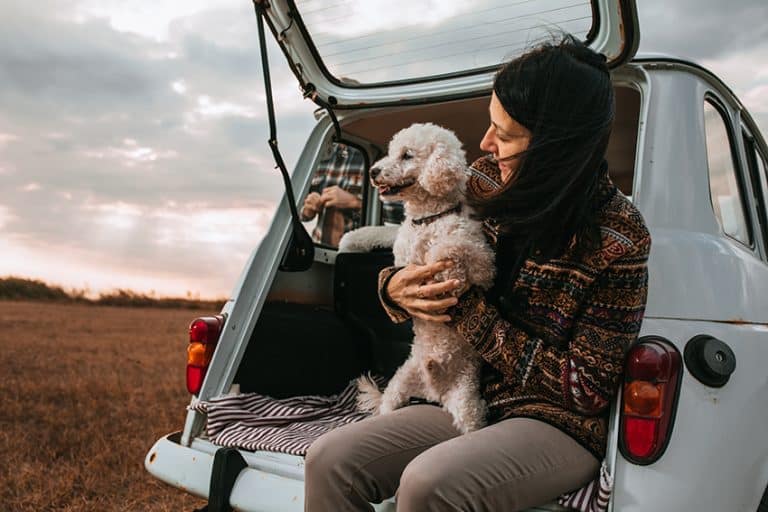
“Walkies”

- Walks are mentally stimulating for dogs
- They’re not made to be lazy but to get up and move
- They may be responding to the instinct to forage
- Walks let your pal check out the neighborhood
- As pack animals, pups relish the opportunity to meet or sniff out other dogs in the area
Remember, dogs can’t get enough of good walks. Take your pal out as often as possible. It will help keep both of you fit, and it’s a great bonding time.
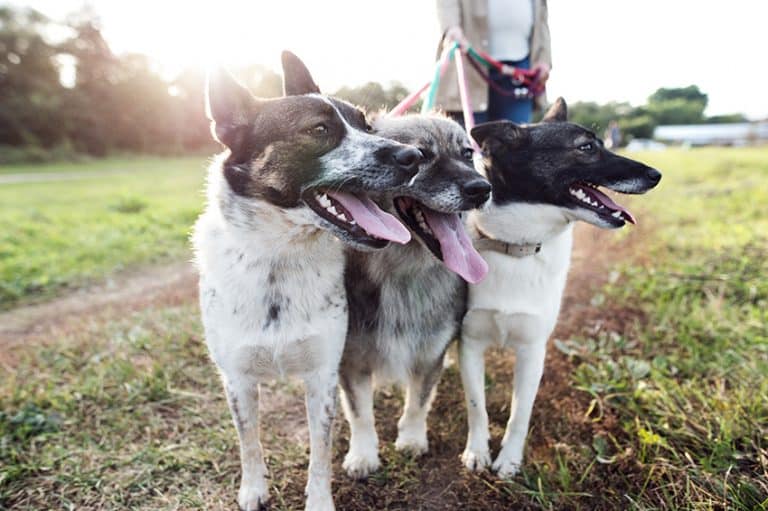
Cuddling


Love Their Human Babies Like Their Own

- Pups and infants have some commonalities. They both crave attention and a playmate.
- Babies may have a scent that’s unique to adult humans.
- The power of the nose also helps to explain why Fido loves babies from their families more than other infants. They have the scent of the pack, and dogs protect their own.
While some dogs can be naturally gentle with babies and help to protect them, it’s best to never leave a baby and dog together unsupervised.
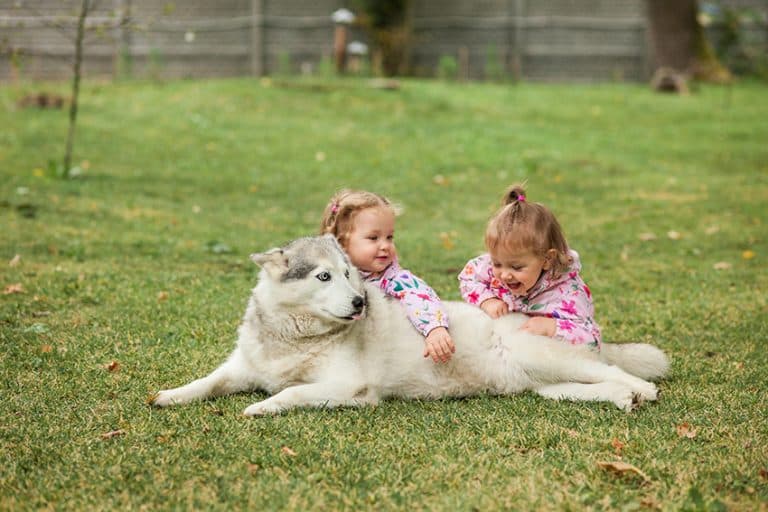
Making Eye Contact With Us

Playing in the Snow

Just like kids, dogs can get more playful and act excited when they see snow. Stephen Zawistowski, Ph.D., Certified Applied Animal Behaviorist describes this behavior: “Dogs like snow because it is cool and different. When we do enrichment for dogs, we provide individual items to increase variety in their environment. Kongs with peanut butter and kibble in paper bags provide a change from the everyday. Snow changes everything: what a dog sees, smells, hears, and feels as it runs/swims through the snow. Knee-deep snow is up to a dog’s chin. When I watch dogs run and play in the snow, it reminds me of kids in a ball pit, diving in and burrowing and having a blast.”
Some reasons that our furry friends get excited in the snow include:
- It changes the way things look
- It stimulates the senses with different smells and feels different – it’s cold!
- It tastes different
Since your canine companion gets such a kick out of snow, why not schedule a snow play date with him? Remember to keep your pooch warm and get him a sweater if he needs one.

Wearing Clothes

Lots of people think it’s cute to dress up their furbaby for holidays, special events, or just because. How that works depends on your pooch’s personality. If he’s calm and patient, give it a try. Some dogs learn to love the clothing and the special attention it brings.
Ice Cubes

Many pups like to munch on ice cubes. What’s up with that?
- Some like making a rasping and crunching sound
- Many dogs like to grind something with their teeth
- It helps them cool down quickly on a hot day
- Playing with ice cubes alleviates boredom
- The cold temperature can help soothe teething pain in puppies.
Why not make your furbaby some homemade frozen treats? He’s probably going to love them.
To Be Scratched and Petted

- It’s pleasurable. We know humans like different forms of touch; it’s easy to assume dogs enjoy it too.
- It could be a social glue that fosters bonding, much in the way mutual grooming builds stronger relationships among primates.
- There are health benefits. We know touch in humans can help lower blood pressure, boost immunity, and reduce stress. Likewise, dogs under stress show a reduced heart rate when being petted by their masters.
- Physical interactions may also serve as a way to determine the emotion of others. People demonstrate the ability, and perhaps dogs can do it too. So, touch may be a way to keep tabs on other members in the household.
Stuffed Animals

Many pooches go crazy for stuffed animals, but some breeds have a greater attraction. Genetics can also determine what your furbaby will do with a plushie:
- Retrievers may prefer to carry the toy around rather than ripping it to shreds. If that’s the case with your pup, remember to wash the object from time to time.
- Terriers and Shepherds love the chase and may prefer to play fetch with a stuffed animal.
- The prey drive in other dogs leads them to shred stuffed toys. If the plushie makes a squeaky sound, that’s even better!
Playing with plushies is normal behavior for canines, but obsession can be a sign of anxiety. Watch how your furry friend interacts with his toy so that you know if something is making him uncomfortable.
Like we told you earlier, dogs can see shades of blue and yellow. So, when you get a new stuffed animal for your special pal, be sure to get a color that pops for Fido.
Tug-of-War

- Tug-of-war served as a friendly competition.
- When pups were familiar with their counterpart, they were more willing to share the toy with their counterpart
- When playing with a much smaller furbaby, dogs naturally self-handicapped
- Dogs play differently with other dogs than they do with humans
Licking Our Sweat

When your four-footed friend licks your arm or legs on a hot day, it doesn’t mean that he’s missing something in his diet. He just likes it.
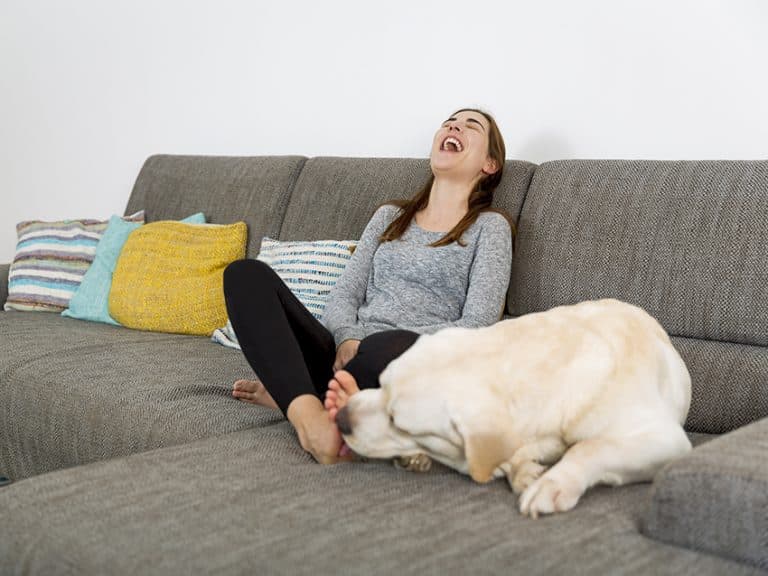
Having Their Belly Rubbed

When our pups roll on their back and expose their belly, it’s hard to resist giving them a good rub. Some canines truly enjoy this contact, but others may only tolerate it. Veterinary Behaviorist Dr. Margaret Gruen, DVM, MVPH, explains that exposing their tummy is an act of submission in dogs. They tend to show the behavior in play and when they’re with trusted humans.

Massages

- It helps to lower blood pressure, improve circulation, and shorten healing times
- It boosts immunity
- It aids digestion
- It can improve balance and movement
- It can ease anxiety in stressful times like thunderstorms
- It provides another way to bond with your furbaby
While you can schedule time with a professional canine massage therapist, you can also learn to do it at home. The American Animal Hospital Association provides a video that teaches you some basic massage techniques to practice on your pooch.
Chewing Shoes

Chasing Laser Pointers

Canines are predators. When they see a moving red light, they want to chase it. A dog’s vision is designed more for motion detection than discerning colors. The erratic motion keys into their instincts and keeps them engaged. That’s why dogs go nuts for laser pointers.
If you want to use a laser pointer to play with your pooch, be aware that there are a few safety issues:
- Lasers can damage the retina so never point the beam at your dog’s eye.
- Pouncing on a light that keeps moving with no reward becomes frustrating for a pup and can lead to behavioral problems.
When you pick up the laser pointer for some play time with your pooch, do something different to counteract the frustration. Try hiding treats around the house and use the laser to lead your pal to the hidden treasures
Blankets

Hate Hugs

How do you know if your hugs are stressing out your special pal? Watch for indicator signs:
- Lip licking
- Licking your face
- Yawning or raising a paw
- Ears lowered or pinned to the side of the head
- Your dog turns his head away from you and may half-close his eyes
- Half-moon or whale eye or showing the whites in the corner or rim of the eye
If your furbaby seems stressed, stop the hugs and show your affection in another way.

Licking Lotion

Does your dog like to lick lotion off your skin when you apply it? They seem to like the taste and aroma of the ingredients. However, not all topical creams are safe for your pooch. Some products can cause unwanted effects like:
- Diarrhea or vomiting
- Panting
- Ulcers
If you have a furbaby that wants to lick up your lotion, be sure you purchase dog-friendly personal care products.
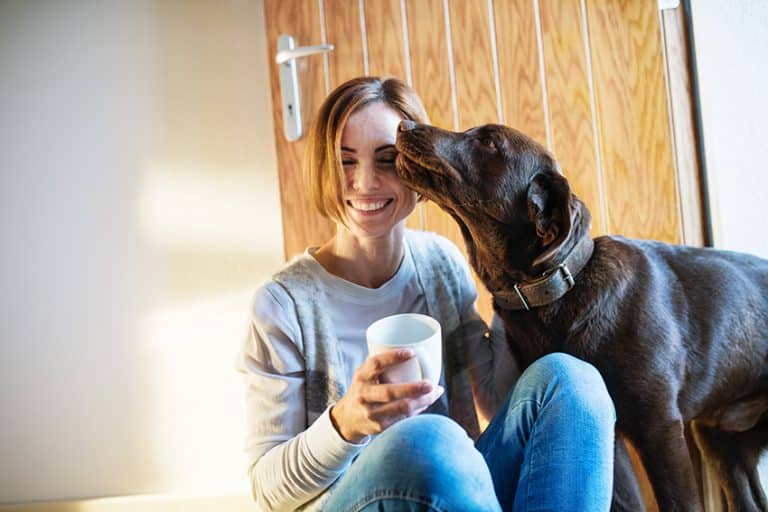
Squeaky Toys

- In some breeds, like terriers, the squeak activates their “prey drive”
- Other pooches may like the sound and think it’s a reward for chomping
- For other furbabies, it could be because that’s the toy that draws our attention
Shredding Toilet Paper

What makes some dogs rip into tissues or toilet paper? It’s linked to instinct. Stanley Coren, PhD., DSc., FRSC explains that canines primarily use their mouths to explore the world. When they encounter something like tissue that mimics the feel of feathers or fur, it can trigger the impulse to tear up or shred the object.
Of course, we don’t like tiny pieces of tissue strewn across the floor. eHow offers some ideas you can use to stop the behavior.
Having Their Ears Rubbed

- Pups may prefer an ear rub from someone they know and feel nervous if a stranger reaches toward their heads without warning. Always use caution with unfamiliar animals.
- If your furbaby suddenly starts to pull away or act like an ear rub is hurting, it’s probably to schedule a veterinary check-up. He may have an infection.
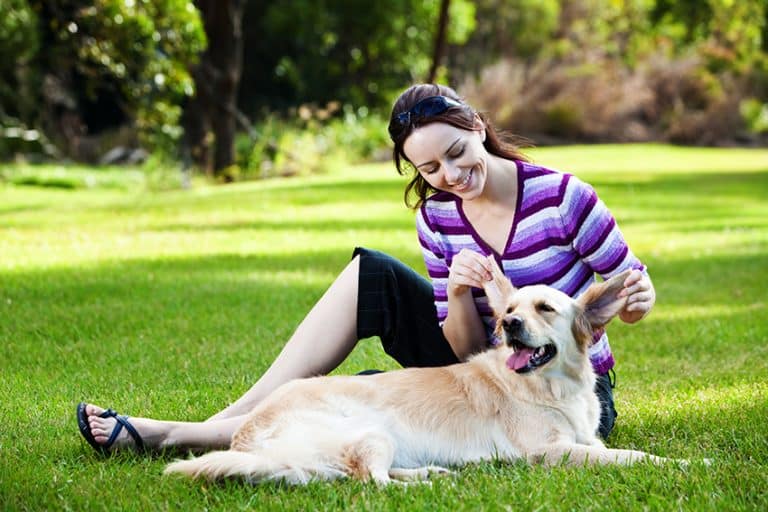
Stealing Dirty Laundry

Is your furbaby a laundry thief? Let’s look at the reason why dogs go for our dirty clothes. Jennifer L. Summerfield, DVM, CPDT-KA explains that dogs like our scent, and when it comes to dirty socks and other laundry, there may be a higher concentration of our smell on the clothing. According to her, “The stronger the smell, the higher the attraction.”
If your pooch goes beyond carrying laundry around, it can be risky. Veterinarians in Portland, OR, found 43 ½ socks in a Great Dane’s stomach!
When you find your pal with dirty laundry, take advantage of the opportunity to train him. Our furbabies rely on us to teach them what we expect them to be doing.After you take the contraband away, offer your pooch a preferred alternative like a stuffed kong or a puzzle toy.
Tennis Balls

Dogs often go crazy for tennis balls. What’s the attraction? Victoria Stillwell, a professional dog trainer, explains that the predatory chase instinct is alive and well in many breeds. When you throw a tennis ball, it mimics the movements that prey make when they’re trying to escape. The chase is on! This love for the fuzzy orbs is one reason scientists use tennis balls to study canine behavior.
Take advantage of your pup’s love for tennis balls by playing fetch with these simple toys. It also helps them overcome boredom and burn off energy.
Playing Fetch

My Springer Spaniel loves this game! What is it about retrieving a toy that’s so attractive?
- It’s hardwired in the genes of some breeds, like Labradors
- The exercise causes the brain to release neurotransmitters like serotonin that gives the dog something akin to a runner’s high
- Chasing and retrieving comes naturally, so it’s fun
- They get to bond with you and get your undivided attention
If Fido doesn’t know how to retrieve, you can get some tips from this teaching video by McCann Dog Training.
Sunbathing

When we sunbathe, the rays help to convert some of our skin’s oils to vitamin D. Once the sun creates the nutrient, our skin absorbs it, and it enters our blood stream. The same conversion happens in dogs but their fur gets in the way of absorption. Pups ingest the vitamin when they self-groom. Most of their nutrients still come from their diet because the conversion and absorption is not that efficient. However, spending time in the sun can boost your furbaby’s Vitamin D.
- Growing pups may produce too much Vitamin D with overexposure. This is a concern because the nutrient serves to regulate blood calcium and other minerals. Too much calcium may affect the development of bones including the teeth and jaws. It can also impact muscle and nerve functions.
- If your pal has a light-colored or white coat, or his hair is short, he’s at a higher risk for sun burns, sunstroke, or heat exhaustion. You can apply a dog-safe sunscreen that’s zinc free for added protection.

Scared of Fireworks

Canines have a baked-in fear of sudden, loud noises, and fireworks top the list. The phobia is part of natural flight instincts to keep your pal safe from danger. During events like Independence Day, our furbabies don’t understand that the sounds they’re hearing are celebration and not some kind of threat. Depending on your pup’s breed and personality, he may respond to the booms by panting, pacing,howling, hiding, or some other behavior
- One thing that could help is creating a safe space for Fido. Reduce outside noise and consider playing relaxing dog music.
- Sit with your pal during the fireworks and offer him a tasty tidbit that he loves with every boom to reassure him that it’s not that bad
- Try an anxiety wrap or weighted blanket to provide comfort
Afraid of Thunder

- Curtiss and Dodman both suggest getting an anti-static jacket, and Dodman recommends using a dryer sheet to rubdown your pooch. These actions could help remove the discomfort of unexpected shocks.
- A snug fitting jacket like the AKC Calming Coat may also help reduce anxiety in your furbaby.
Sounds Only a Dog Can Hear and Hate

Not only do dogs have stronger sense of hearing than people, but they can also hear higher frequencies. The human frequency range is between 64 and 23,000 Hz, while in dogs it stretches from about 67-45,000 Hz. However, higher frequencies (above 25,000 Hz) can be uncomfortable for Fido. If the sound is loud, it can be even more painful.
Check out our guide on Dog Whistles to learn more about safe ways to use high frequency sounds to train your pooch.
Afraid of Vacuum Cleaners

- They only hear the noise when you’re vacuuming, and it’s loud and scary for them. Dr. Diane Levitan, veterinarian says, “Large ‘critters’ that make very loud noises are threatening to the dog—even if it does not breathe.”
- The vacuum’s action can kick up unfamiliar or unpleasant scents.
- The suction resembles how a dog sniffs the environment, but it’s more violent. This could be intimidating to some pups.
Get Frustrated When You Don’t Appreciate Their Barking at the Mailman

- Animal expert Libby Brittain believes dogs show aggression because the way the mail carrier repeatedly invades their territory triggers a fear of the unknown. Mark D. Freeman, DVM, an Assistant Professor at VA-MD College of Veterinary Medicine adds “Dogs have an inherent need to defend their territory from intruders.”
- Another reason for barking is that it’s a learned behavior. A stranger shows up at the house day after day and leaves when Fido barks. According to Dr. Freeman, “Any self-respecting dog will consider this a threat, and will react accordingly, barking to sound the alarm and warn off the intruder.”
- Brittain also suggests that shelter dogs may be reacting to the uniform because it reminds them of a traumatic event.
- Introduce Fido to your mail carrier the same way you would with a visiting friend so that he knows there’s nothing to fear about this person.
- Leave a note for your delivery person and let them know your pooch’s name. Then they can address your pal by name.
- Consult with a canine behavioral expert like Cesar Millan.
Hates Getting Baths

It’s hard to say whether dogs hate baths or a trip to the vet more. What makes them so nervous?
- Even dogs that love to go swimming resist being bathed because they’re not in control of the situation. Board-certified animal behaviorist,Emily Levine says, “There’s fun with swimming, versus a bath, where they’re being put in a situation and having water dumped all over them.”
- In some cases, dogs associate bath time with bad memories.
- They may feel insecure if the tub is slippery.
- A bath is a weird experience that doesn’t happen very often, so it can be unnerving.
- Some dogs don’t like to be handled that much.
For a positive bath experience, try offering your pal a tasty reward for good behavior by smearing peanut butter in this treat dispenser.
Most Hated Smells

With such a heightened sense of smell, it’s no wonder that pooches have some scents that turn them off. The aromas that top the list of hated smells for dogs are:
- Citrus aromas like lemon and orange are too intense for their sensitive noses
- Vinegar can burn their noses
- Chili pepper can cause respiratory discomfort
- Rubbing alcohol
- Nail polish
- Cleaning products including chlorine and ammonia
- Perfumes
When you’re playing scent games with your pooch, be sure you don’t use a hated smell like lemon. You can also select cleaning products that won’t irritate your pal’s nose.
Get Mad When You Show Them the Middle Finger

The bottom line is that it’s best to avoid using the finger with your pooch. If you use the gesture, try putting a treat on top of your finger. That’s something your furry friend will appreciate!
Hate it When You Blow in Their Face

You may think it’s fun to blow in your pup’s face, but he hates it. Here’s why:
- The sensation is unexpected and dogs don’t like it
- Dogs can’t blow air out of their mouths, so it’s confusing to them
- The airstream can dry their nose and eyes and impair their senses
- The smells from your breath irritate his nose
- You invade his personal space when you do it
The take-home message is: don’t engage in this game for your safety and your pup’s sanity.
Hate Having Their Paws Touched

So, if your pooch hates it when you touch his paws, you may be able to train your pooch to let you handle them. Remember to start slow and keep practicing with each foot throughout his life.
- Pick up a paw and immediately release it. Click and treat concurrently
- Repeat several times and build to holding the paw for a second before releasing it
- Build to holding the paw for 10 seconds without any struggling from Fido
- Move paw around while holding it up
- Massage the footpad
- Act like you’re trimming the nails
The initial sessions may need to occur dozens of times over several days.

Turn Away From Cameras

Get Mad When You Pull Their Tail

The thing to remember about dog tails is it’s not like a ponytail. It’s an appendage just like one of their legs. It has bone, muscle, tendons, and nerve endings that connect to the body.
Canines use their tails for balance and to communicate their moods. When scientists in Italy studied how dogs use this fifth limb for communication, they learned that pups instinctively get messages from other canine’s tails.
Our furry friends also use their tails to share scent information. A confident canine will hold his tail high and let other pooches take a sniff of his butt. However, if Fido is nervous, he’ll clamp it down.
Some breeds have long, fluffy tails that help keep them warm in cold climates. They’ll curl up in a tight ball and tuck their nose in the feathering. For sled dogs, it also comes in handy as a rudder.
The bottom line is, you shouldn’t tug at Fido’s tail. It’s an important part of their body, and pulling it can interfere with so many key functions.
Afraid of the Dark

If your special pal suffers from this phobia, your best bet is to contact a veterinary behavior specialist or a certified trainer. They can guide you through the steps of gradually exposing your furbaby to the fearful stimulus to desensitize them. This process will involve lots of positive reinforcement and treats. Ideally, try to head off the issue before a small fear grows to full-blown phobia. The key here is recognizing the early signs, ruling out any health problems, and seeking professional help.
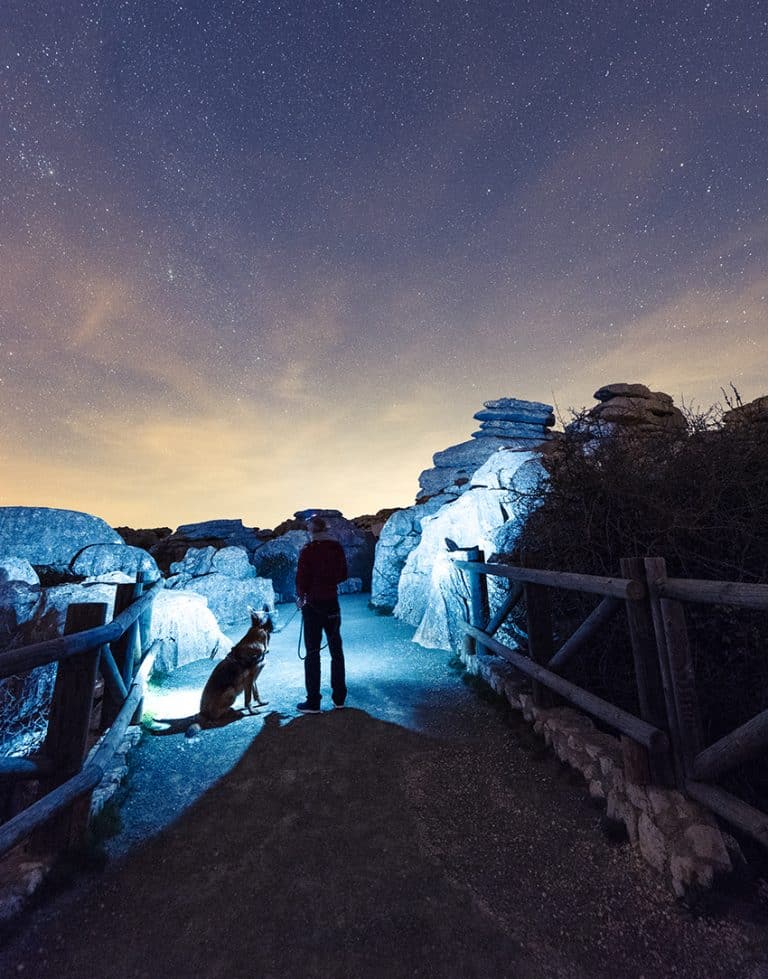
Did Some of Our Answers Surprise You?
Hopefully the information we provided above will help you understand your furbaby’s preferences so that you can keep him more content. Remember, a happy dog is a healthy dog.
